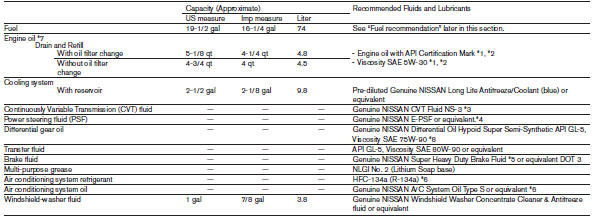Capacities and recommended fuel/lubricants
The following are approximate capacities. The actual refill capacities may be slightly different. When refilling, follow the procedure described in the “Maintenance and do-it-yourself” section to determine the proper refill capacity.

*1: For further details, see “Engine oil and oil filter recommendations” in this section.
*2: NISSAN recommends Genuine NISSAN Ester Oil available at a NISSAN dealer.
*3: Use only Genuine NISSAN CVT Fluid NS-3. Using transmission fluid other than Genuine NISSAN CVT Fluid NS-3 will damage the CVT, which is not covered by the NISSAN new vehicle limited warranty. *4: Use of power steering fluid other than Genuine NISSAN E-PSF will prevent the power steering system from operating properly.
*5: Available in mainland USA through a NISSAN dealer.
*6: For further details, see “Air conditioner system refrigerant and oil recommendations” in this section.
*7: For further details, see “Engine Oil” in the “Maintenance and do-it-yourself” section of this manual.
*8: The use of differential gear oil other than the specified may cause vehicle malfunctions and result in non-warranty vehicle repairs.
- Fuel recommendation
- Engine oil and oil filter recommendations
- Air conditioner system refrigerant and oil recommendations
See also:
Rear window wiper blade
Contact a NISSAN dealer if checking or replacement is required. ...
Hardtop models
1. Hood
2. Headlight and turn signal lights
— Switch operation
— Bulb replacement
3. Windshield wiper and washer
— Switch operation
— Rain-sensing auto wiper system
— Blade replace ...
Foreword
Welcome to the growing family of new NISSAN
owners. This vehicle is delivered to you with
confidence. It was produced using the latest
techniques and strict quality control.
This manual was prep ...
